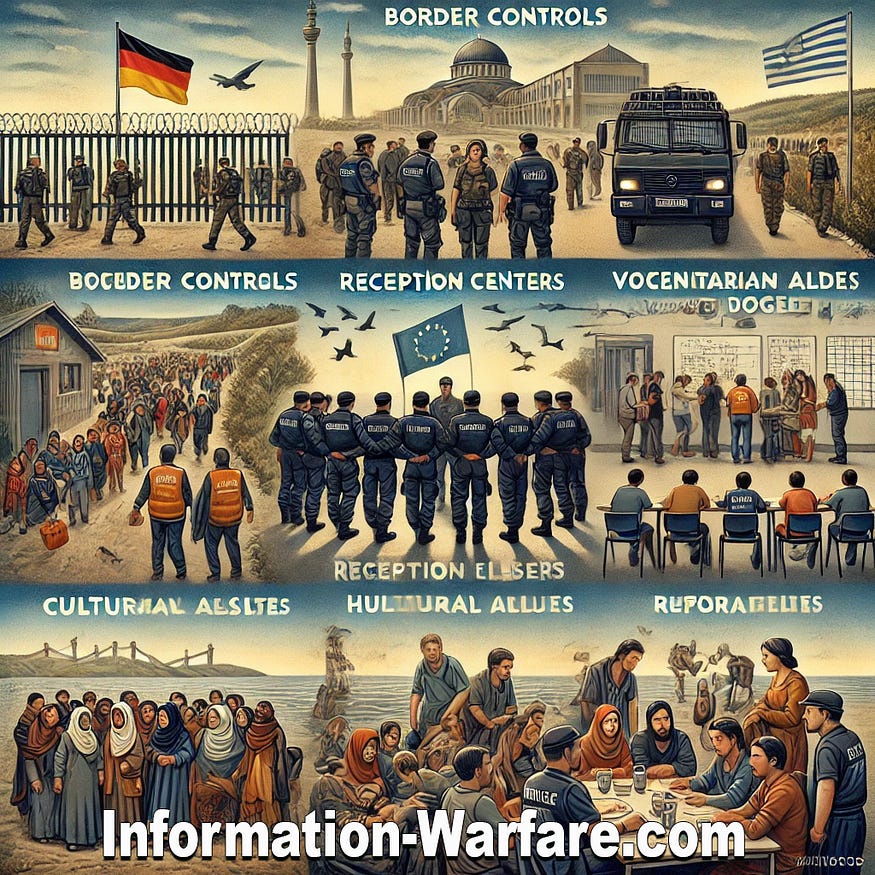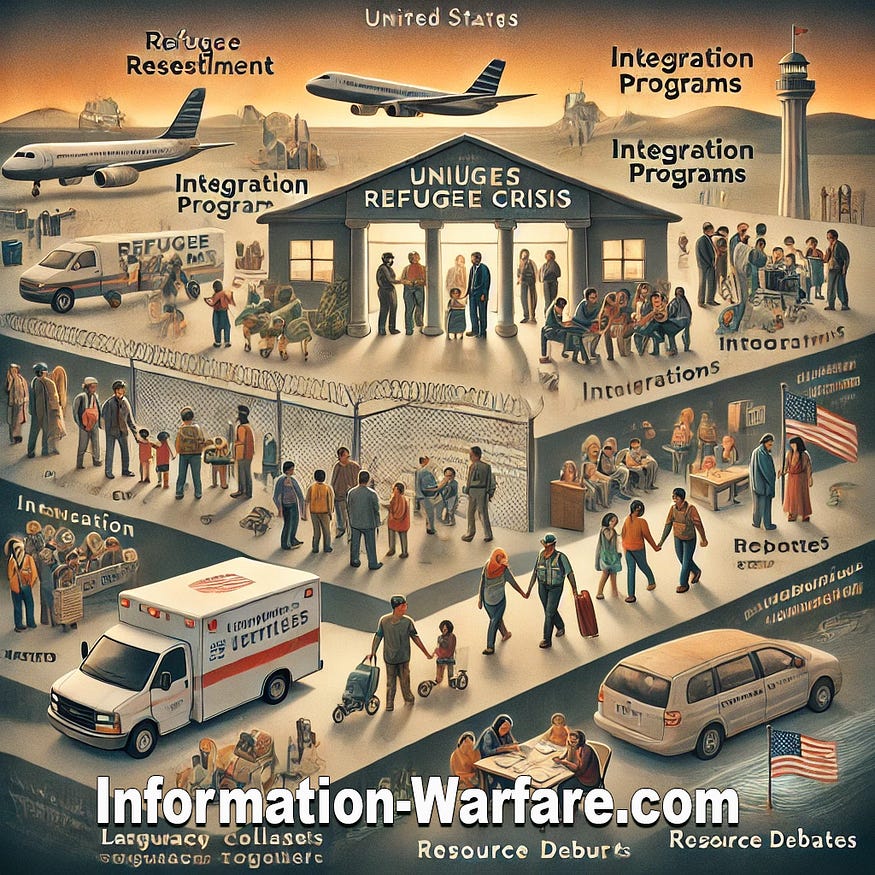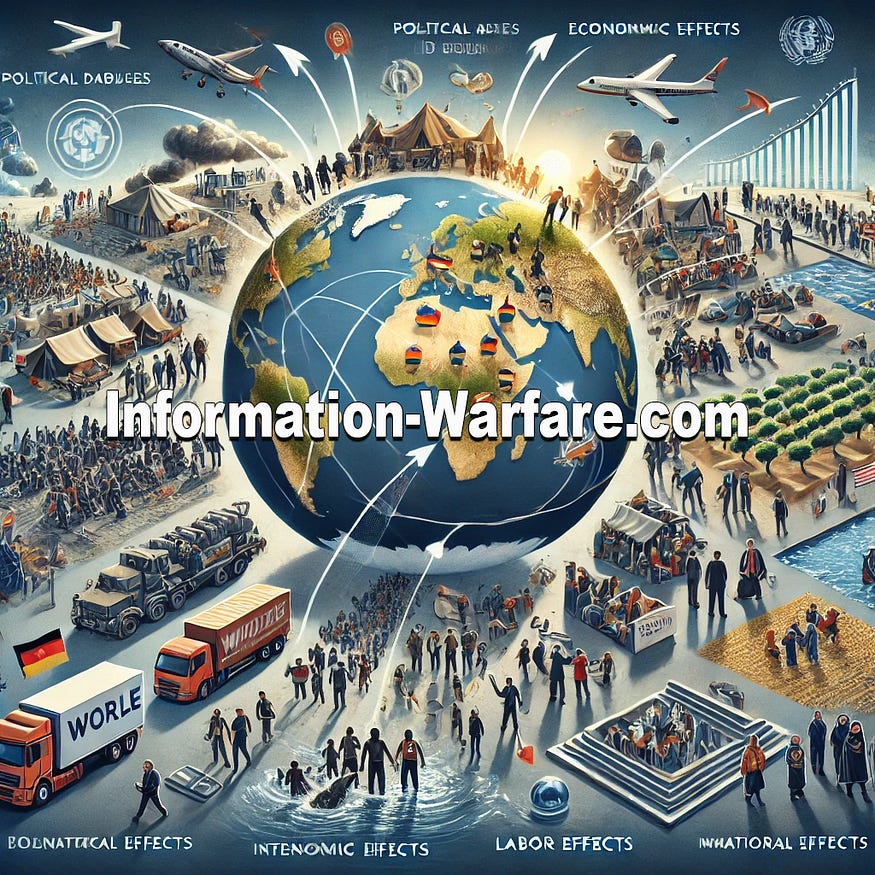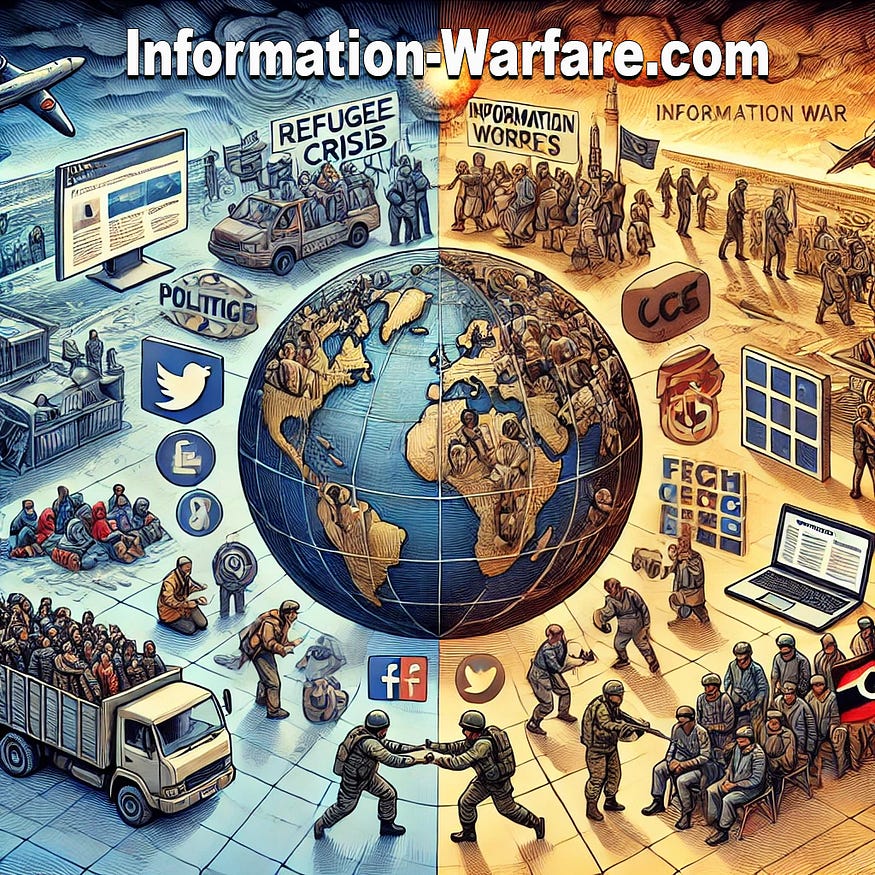The Global Refugee Crisis
The Role and Impact of Refugee Crisis in Information Warfare
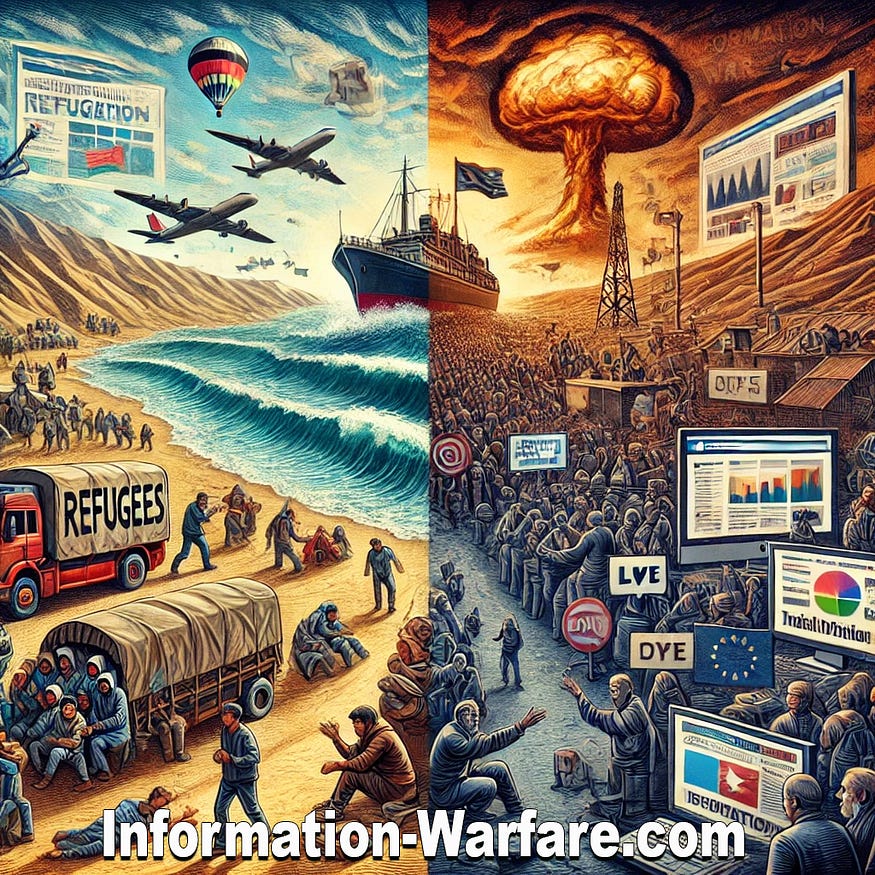
The refugee crisis refers to the large-scale displacement of people who flee their home countries due to conflict, persecution, violence, and human rights violations. These individuals seek refuge in other countries, often facing perilous journeys and challenging conditions upon arrival. Here are the key aspects of the refugee crisis:
Causes of Displacement
Conflict and War: Wars and armed conflicts are primary drivers of displacement. Countries like Syria, Afghanistan, South Sudan, and Myanmar have seen significant numbers of people fleeing due to prolonged violence.
Persecution: Many refugees flee due to persecution based on race, religion, nationality, political opinion, or membership in a particular social group. This persecution can come from governments or other groups within their home country.
Human Rights Violations: Severe human rights abuses, including torture, sexual violence, and forced labor, force individuals to seek safety elsewhere.
Natural Disasters and Climate Change: While not always categorized under the traditional refugee definition, environmental factors such as natural disasters and climate change are increasingly causing displacement.
Journey and Challenges
Dangerous Routes: Refugees often undertake dangerous journeys, crossing seas, deserts, and mountains. Many risk their lives in unsafe boats or on foot, facing threats from smugglers, traffickers, and hostile environments.
Refugee Camps: Upon reaching safety, many end up in overcrowded refugee camps with inadequate resources. These camps can lack sufficient food, clean water, healthcare, and sanitation facilities.
Legal and Asylum Processes: Refugees must navigate complex legal systems to seek asylum. This process can be lengthy, with many facing uncertainty and prolonged periods in detention centers.
Global Distribution and Statistics
Host Countries: The majority of refugees are hosted by developing countries. Nations like Turkey, Pakistan, Uganda, and Lebanon host large numbers of refugees relative to their population size.
Statistics: According to the UNHCR, there were over 26 million refugees worldwide as of 2020. This number continues to grow as conflicts and crises persist.
International Response
Humanitarian Aid: International organizations like the United Nations High Commissioner for Refugees (UNHCR), NGOs, and various governments provide humanitarian aid, including food, shelter, healthcare, and education.
Resettlement Programs: Some refugees are resettled to third countries through international resettlement programs. However, the number of available resettlement places is far fewer than the need.
Policies and Agreements: Various international agreements, such as the 1951 Refugee Convention and the Global Compact on Refugees, aim to protect the rights of refugees and promote international cooperation.
Challenges and Controversies
Resource Strain: Host countries, particularly those with limited resources, face significant challenges in providing for large numbers of refugees.
Political and Social Tensions: The presence of refugees can lead to political and social tensions in host countries, with debates over resource allocation, security, and cultural integration.
Misinformation: Refugees often face stigmatization and discrimination fueled by misinformation and xenophobia.
The refugee crisis is a complex, multifaceted humanitarian issue driven by conflict, persecution, and human rights violations. It involves perilous journeys, challenging living conditions, and the need for international cooperation and support. Addressing the crisis requires a comprehensive approach that includes providing humanitarian aid, protecting refugees’ rights, and finding long-term solutions such as safe repatriation, local integration, or resettlement.
How Europe is Dealing with the Refugee Crisis
The refugee crisis has posed significant challenges to Europe over the past decade. With conflicts, persecution, and economic hardships driving people from countries like Syria, Afghanistan, and various parts of Africa, Europe has had to develop multifaceted approaches to manage the influx of refugees. Here’s an overview of how Europe is dealing with the refugee crisis:
Policy Frameworks and Agreements
European Union Policies: The EU has implemented several key policies, such as the Common European Asylum System (CEAS), which aims to ensure fair and humane treatment of asylum seekers. The Dublin Regulation determines which EU country is responsible for processing an asylum seeker’s application, typically the first country of entry.
EU-Turkey Deal: In 2016, the EU and Turkey struck a deal to curb the flow of refugees into Europe. Under this agreement, Turkey agreed to take back migrants crossing into Greece in exchange for financial aid, visa liberalization for Turkish citizens, and renewed EU accession talks.
Border Management and Security
Strengthened Border Controls: Europe has significantly increased border controls, especially along the external borders of the Schengen Area. The European Border and Coast Guard Agency (Frontex) plays a crucial role in monitoring and securing these borders.
Reception Centers and Hotspots: To manage the influx more effectively, the EU established hotspots in frontline countries like Greece and Italy. These centers facilitate the registration, identification, and fingerprinting of refugees and migrants.
Relocation and Resettlement Programs
EU Relocation Scheme: To relieve pressure on countries most affected by the crisis, the EU launched a relocation scheme to distribute asylum seekers across member states. While the program faced resistance from some countries, it has helped to share the responsibility more evenly.
Resettlement Initiatives: Europe has also engaged in resettlement programs, working with the UNHCR to transfer refugees directly from countries of first asylum (like Lebanon and Jordan) to EU member states.
Humanitarian Assistance and Integration Efforts
Humanitarian Aid: The EU and individual European countries provide significant humanitarian aid to regions affected by conflict and displacement. This includes financial support, food aid, and medical assistance.
Integration Programs: Efforts to integrate refugees into European societies vary by country. Germany, for example, has implemented comprehensive integration courses that include language training, vocational education, and cultural orientation. Other countries offer similar programs aimed at helping refugees become self-sufficient and integrated into their new communities.
Addressing Root Causes
Foreign Policy and Development Aid: Europe is also focusing on addressing the root causes of migration. This includes supporting peace-building efforts, development projects, and economic assistance in countries of origin to reduce the need for people to flee.
Partnerships with African Countries: The EU has developed partnerships with African countries to manage migration more effectively. These partnerships often include financial aid, investment in local infrastructure, and support for education and job creation to improve living conditions in these regions.
Challenges and Criticisms
Human Rights Concerns: Europe’s handling of the refugee crisis has faced criticism, particularly regarding the conditions in reception centers and the treatment of asylum seekers. Human rights organizations have raised concerns about overcrowding, inadequate facilities, and delays in processing asylum claims.
Political Tensions: The refugee crisis has fueled political tensions within and between EU member states. Some countries have been more welcoming, while others have resisted accepting refugees, leading to disagreements over shared responsibilities and border policies.
Public Sentiment: Public opinion on refugees varies widely across Europe. While many citizens and organizations support humanitarian efforts and integration, there is also significant opposition fueled by economic concerns, security fears, and cultural integration challenges.
Europe’s response to the refugee crisis is complex and multifaceted, involving a combination of policy frameworks, humanitarian assistance, border management, and integration efforts. While significant progress has been made in managing the influx and supporting refugees, challenges remain in ensuring fair treatment, integration, and addressing the root causes of migration. The ongoing efforts to balance humanitarian responsibilities with security and economic considerations will continue to shape Europe’s approach to the refugee crisis in the years to come.
How the United States is Dealing with the Refugee Crisis
The United States plays a significant role in addressing the global refugee crisis through various policies, programs, and international cooperation. Here’s an overview of how the U.S. is managing the refugee situation:
Policy Frameworks and Resettlement Programs
U.S. Refugee Admissions Program (USRAP): USRAP is the primary mechanism through which the U.S. resettles refugees. Managed by the Department of State, the Department of Homeland Security, and the Department of Health and Human Services, USRAP involves rigorous vetting processes to ensure the security and eligibility of refugees for resettlement.
Annual Refugee Admission Ceilings: Each year, the President sets a cap on the number of refugees allowed to enter the U.S. This ceiling fluctuates based on global needs and domestic policy priorities. Recent years have seen increases in these numbers to address growing humanitarian needs.
Asylum Seekers and Legal Protections
Asylum Applications: Individuals already present in the U.S. can apply for asylum if they meet the criteria for persecution based on race, religion, nationality, membership in a particular social group, or political opinion. Asylum seekers undergo a legal process to determine their eligibility for protection.
Temporary Protected Status (TPS): TPS provides temporary legal status to nationals of certain countries experiencing ongoing armed conflict, environmental disasters, or other extraordinary conditions. This status allows individuals to live and work in the U.S. without fear of deportation.
Integration and Support Services
Resettlement Agencies: Various non-profit organizations, in partnership with the government, provide essential services to newly arrived refugees. These services include housing assistance, language classes, employment support, and cultural orientation to help refugees integrate into American society.
Community and State Programs: States and local communities play a crucial role in supporting refugees. Community-based organizations often offer additional resources and support networks to facilitate successful integration.
Challenges and Criticisms
Political Debates: U.S. refugee policy is often a topic of political debate. Different administrations have varied approaches to refugee admissions, impacting the number of refugees accepted and the policies implemented.
Legal and Bureaucratic Hurdles: The asylum process can be lengthy and complex, leading to backlogs and prolonged uncertainty for asylum seekers. Legal reforms and resource allocation are ongoing challenges to improve the system’s efficiency.
Public Opinion: As in other parts of the world, public opinion on refugees in the U.S. is divided. While many Americans support humanitarian efforts, others express concerns about security and economic impact.
The United States continues to play a vital role in addressing the refugee crisis through resettlement programs, asylum protections, and integration efforts. Despite challenges, the U.S. remains committed to providing refuge to those fleeing persecution and conflict, contributing to global humanitarian efforts.
The Global Impact of the Refugee Crisis
The refugee crisis has far-reaching effects, impacting not only the countries that host large numbers of refugees but also the broader international community. The consequences span humanitarian, economic, political, social, and environmental dimensions. Here’s an overview of how the world is being affected by the refugee crisis:
Humanitarian Impact
Displacement and Human Suffering: Refugees often flee from war, persecution, and violence, leading to widespread human suffering. Many endure dangerous journeys and face dire conditions in refugee camps and urban settlements. Humanitarian organizations are often overwhelmed by the need to provide basic necessities such as food, shelter, healthcare, and education.
Strain on Resources: Host countries, particularly those neighboring conflict zones, face significant pressure on their resources and infrastructure. Countries like Lebanon, Jordan, and Turkey, which host millions of Syrian refugees, struggle to provide adequate services and support.
Economic Impact
Cost to Host Countries: Hosting large numbers of refugees can be costly for countries, particularly those with limited resources. Providing healthcare, education, housing, and other social services to refugees requires substantial financial investment.
Labor Markets and Economies: In some cases, refugees can positively contribute to the labor market, filling gaps and helping to stimulate economic growth. However, there can also be competition for jobs, leading to tensions with local populations. The economic impact varies depending on the host country’s economic conditions and policies towards refugees.
International Aid and Funding: The global community often provides financial aid to support refugee-hosting countries. However, the demand for aid frequently outstrips available resources, leading to funding shortages and cuts in essential services.
Political Impact
Policy and Governance Challenges: The influx of refugees poses significant challenges for national and local governments. Developing and implementing effective policies for refugee integration, border security, and asylum processes requires careful balance and coordination.
Rise of Populism and Nationalism: The refugee crisis has fueled the rise of populist and nationalist movements in many countries. Political parties and leaders often use anti-immigrant rhetoric to gain support, leading to increased polarization and xenophobia.
International Relations: The refugee crisis affects diplomatic relations and international cooperation. Disagreements over burden-sharing and refugee resettlement can strain relationships between countries and within international organizations like the European Union.
Social Impact
Integration and Social Cohesion: Integrating refugees into host communities can be challenging. Differences in language, culture, and religion can lead to social tensions and misunderstandings. Successful integration requires comprehensive support programs and efforts to promote mutual understanding and respect.
Public Perception and Attitudes: Public attitudes towards refugees vary widely. In some countries, there is strong support for helping refugees, while in others, there is significant opposition and fear. Media coverage and political rhetoric play crucial roles in shaping public perception.
Education and Youth: Refugee children and youth often face disruptions in their education, which can have long-term impacts on their development and future opportunities. Ensuring access to quality education is essential for their integration and empowerment.
Environmental Impact
Environmental Degradation: The sudden influx of large numbers of refugees can lead to environmental degradation, particularly in areas with limited resources. Deforestation, water scarcity, and waste management challenges are common issues in and around refugee camps.
Sustainable Solutions: Addressing the environmental impact of the refugee crisis requires sustainable solutions, including the development of eco-friendly infrastructure and practices in refugee camps and settlements.
Global Security
Conflict and Instability: The refugee crisis is both a consequence and a driver of conflict and instability. Large movements of people can exacerbate tensions in already fragile regions, leading to further displacement and violence.
Terrorism and Radicalization: There are concerns that inadequate integration and social exclusion of refugees can contribute to radicalization and recruitment by extremist groups. Addressing these risks requires comprehensive strategies that promote inclusion and address underlying grievances.
The refugee crisis is a complex and multifaceted challenge with profound global implications. It affects humanitarian conditions, economic stability, political dynamics, social cohesion, environmental sustainability, and global security. Addressing the refugee crisis requires coordinated international efforts, long-term planning, and a commitment to upholding human rights and dignity. The global community must work together to find sustainable solutions that support both refugees and host communities, ensuring that the needs and rights of displaced people are met while fostering stability and development worldwide.
The Correlation Between the Refugee Crisis and the Information War
The refugee crisis and the information war are intricately linked, with each influencing the other in significant ways. This correlation affects public perception, policy-making, international relations, and the overall handling of the refugee situation. Here’s an exploration of how the refugee crisis correlates with the information war:
Manipulation of Public Perception
Disinformation Campaigns: Misinformation and disinformation about refugees are commonly spread through social media, news outlets, and other platforms. These false narratives often portray refugees as security threats, economic burdens, or cultural invaders, fueling fear and hostility among local populations.
Influence on Public Opinion: The information war shapes public opinion by emphasizing negative stereotypes and sensationalist stories about refugees. This manipulation can lead to increased xenophobia and resistance to refugee policies, making it more challenging to garner support for humanitarian initiatives.
Polarization and Division: Disinformation efforts exacerbate social and political polarization. By spreading divisive content, actors involved in the information war can deepen societal rifts, making it harder to achieve consensus on refugee-related policies and actions.
Impact on Policy and Governance
Policy Resistance: Misinformation can lead to public opposition to refugee-friendly policies. Politicians, influenced by their constituents’ fears and misconceptions, may enact stricter immigration controls and reduce support for refugees, regardless of the humanitarian need.
Security Policies: False narratives about refugees being linked to terrorism or crime can result in the implementation of more stringent security measures. These measures might be disproportionate to the actual threat, leading to human rights violations and further stigmatization of refugees.
International Relations: Disinformation campaigns can strain international relations by creating distrust between countries. For instance, when countries accuse each other of mishandling refugee situations or spreading false information, it can hinder cooperation and coordinated responses to the crisis.
Weaponization of the Crisis
Political Tool: The refugee crisis is often used as a political tool in the information war. Politicians and interest groups may exploit the crisis to advance their agendas, whether it be to rally support for nationalist policies or to discredit political opponents.
Propaganda: Both state and non-state actors use the refugee crisis in their propaganda efforts. For example, authoritarian regimes might use the crisis to justify harsh border controls and crackdowns on dissent, presenting themselves as protectors of national security.
Destabilization Tactics: Some actors may intentionally spread false information about refugees to destabilize regions or countries. By inciting fear and division, they aim to weaken political structures and create chaos, which can be exploited for strategic gains.
Challenges for Humanitarian Efforts
Obstacles to Aid: Disinformation can undermine humanitarian efforts by discrediting organizations that provide aid to refugees. Accusations of corruption, inefficiency, or hidden agendas can erode public trust and reduce donations and support for these organizations.
Operational Difficulties: Humanitarian organizations may face operational challenges due to the hostile environment created by misinformation. Staff may encounter resistance or violence from local populations influenced by negative perceptions of refugees.
Advocacy and Awareness: Efforts to raise awareness and advocate for refugee rights are hindered by the information war. Misinformation campaigns can drown out factual information and hinder the ability to mobilize support for refugee protection and assistance.
Role of Technology and Media
Social Media Influence: Social media platforms are a battleground in the information war. They amplify both accurate and false information about refugees, making it challenging for users to discern the truth. Algorithms that prioritize engagement over accuracy can exacerbate the spread of disinformation.
Media Responsibility: Traditional media outlets play a crucial role in shaping narratives about refugees. Responsible reporting can counteract disinformation, while sensationalist or biased coverage can contribute to negative perceptions and misinformed public opinion.
Fact-Checking and Countermeasures: Initiatives to counter disinformation, such as fact-checking organizations and digital literacy programs, are essential in combating the negative effects of the information war on the refugee crisis. These efforts help to provide accurate information and promote critical thinking among the public.
Conclusion
The refugee crisis and the information war are deeply interconnected, with each influencing the other in profound ways. Disinformation campaigns and false narratives about refugees shape public perception, impact policy-making, and hinder humanitarian efforts. The weaponization of the refugee crisis as a political tool further complicates the situation, creating obstacles to effective solutions and international cooperation.
Addressing the correlation between the refugee crisis and the information war requires a multi-faceted approach. This includes promoting accurate and responsible reporting, enhancing digital literacy, and supporting fact-checking.


